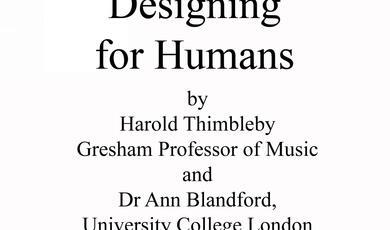Early Mathematics Day: Solving the mystery of the World's First Computer
Share
- Details
- Transcript
- Audio
- Downloads
- Extra Reading
In 1900 a group of sponge divers blown off course in the Mediterranean discovered an Ancient Greek shipwreck dating from around 70 BC. Lying unnoticed for months amongst their hard-won haul was what appeared to be a formless lump of corroded rock.
Download Transcript
6 May 2011 Decoding the Heavens: Solving the Mystery of the World’s First Computer Jo Marchant This is what I will be talking about – the biggest surviving part of it anyway. The Antikythera mechanism dates from the early 1st or 2nd century BC, and it is a clockwork mechanical calculator. Some people call it a computer. It is the most sophisticated scientific artefact that survives from antiquity – in terms of a physical object that we have in our hands there is nothing else like it. You can see gear wheels here – at least thirty survive. We do not have another single gear wheel that survives from the ancient world. Nothing as sophisticated as this appears for well over a thousand years afterwards, just to give you a sense of how unique this is. First, I am going to give you a bit of background about how it was discovered. Then I shall talk you though what it did, what it was for, what it calculated. I shall then talk about where that knowledge and technology came from as far as we know, and what happened to it afterwards. The Antikythera mechanism was discovered by a crew of sponge divers from the island of Syme, in the eastern Mediterranean. They spent the summer diving for sponges just off the coast of North Africa, but on their way home (around the autumn of 1900) they were blown off course by a storm and took shelter by the island of Antikythera. It is a tiny island, barely inhabited. They found a shipwreck. The Greek government hired them to salvage it, which took about ten months. The site is at about 60 metres depth, which in the suits that they had was incredibly dangerous. One of them died from the bends, two of them were paralysed from the operation. They brought back the most incredible haul of treasure from the ancient world that had been found up until that point. They mostly found bronze and marble statues, which can be seen in the National Archaeological Museum in Athens. The bronzes fared pretty well although they had to be reconstructed from pieces. It was a Roman ship carrying Greek treasure, probably stolen Greek treasure from the eastern Mediterranean that was being carried back to Rome when the ship sank. While all this stuff was coming back to the museum, staff were desperately trying to put the pieces back together. The finds were making headlines around the world. It was 1901. Anything that could not be identified was just thrown into a crate, and this particular piece of rock sat in an open courtyard for months before it cracked open. We do not know if someone hit it with a hammer or if it just dried and broke open. Nevertheless, inside was this. Gear wheels, pointers, precisely marked scales, inscriptions. It was like nothing anyone had ever seen from the ancient world. People did not know what to make of it. This is the largest surviving piece of the Antikythera mechanism. Here is another piece where you can see what looks like concentric dials. Here is a third piece where you can see two dials that are marked very precisely. It looks modern, much like a protractor that you might have used in school. You can see a lot of inscriptions here. People were very excited about it. They assumed that it had something to do with astronomy (because it had the names of the months on it), that it was Greek (the writing is in Greek) and that it dated from around the time of the shipwreck, which was early first century BC (although this particular artefact is probably a bit older than that) Beyond that, however, no one really made much progress. Unfortunately, I do not have time today to go into the hundred years of research that happened since its discovery, but one of the most important researchers was Derek Price, a British historian of science who worked at Yale. He was the first to X-ray the pieces and look at the gear wheels inside and how they fitted together. This is what he said about it: “If it is genuine the Antikythera machine must entail a complete re-estimation of ancient Greek technology. Its discovery 55 years ago was as spectacular as if the opening of Tutankhamun’s tomb had revealed the decaying but recognisable parts of an internal combustion engine.” Price was one of the first to really get the significance of this find. Unfortunately, he got a lot right about what it did, but he also got a lot wrong. Michael Wright, who lives in Hammersmith, was a curator at the Science Museum and he also X-rayed the pieces. Then, a big international team with sophisticated X-ray 3D scanning technology came along and looked at it as well. Their combined efforts produced this diagram, which I think shows just how complicated the Antikythera mechanism was. This represents the thirty or so surviving gear wheels, but we think that there were probably many more which have been lost. I am going to take you through some of this. First of all, what did it calculate? This is Michael Wright’s reconstruction of the machine. We do not know exactly how all of the bits fitted together but this is probably the most accurate model that we have. It was not necessarily exactly like this but this is pretty good. It was bronze – the gear wheels and mechanism inside, as well as the dials on the front and back – housed in a wooden box with a handle on the side. You would operate it by turning a handle on the side and it tells you everything about the sky at any particular moment in time. It is giving you the positions of the Sun, Moon and planets on the front here. There are two dials here. The zodiac dial shows the 12 signs of the zodiac and is divided into 360 degrees. And there is a calendar, showing the days and months of the year. Then, there are pointers going around the main dial, which show you the positions of the Sun and the Moon, and possibly the planets. As you turn the handle you can turn forwards and backwards in time and it shows you all of those bodies in the sky and what they are doing. These are the names of the Sun, Moon and planets here, you have got days of the month round here, and these are the dials. This is a star calendar or parapegma. As the date pointer reaches one of those letters, you refer down to the corresponding letter at the bottom and it tells you what stars are rising and setting at that particular moment in time. There is also this little ball here, which rotates and shows you the phase of the moon. These are some of the inscriptions from the star calendar, which show the kind of information you are getting. There are other inscriptions as well, which have not been completely read, there are just fragments of it. But they look like instructions, explaining what is going on in the mechanisms. This is what is going on in the back. These are two spiral dials. It was only recognised quite recently that they are spirals, they are not concentric circles. This top one is a 235-month repeating calendar. This pointer is like the stylus on a record player. It is quite clever. You start here, and as it goes round it extends, the arm gets longer as it goes around the spiral, until it gets to the end. When you have finished you just pick it up and put it back to the beginning, and it goes again. This is a close-up of a little subsidiary dial, which was initially thought to be a way of multiplying this calendar. This is a 235-month calendar, which I shall return to in a minute, but the Greeks also used a calendar that was four times that, which was more accurate. So it was thought that this was enabling you to read four sets of these 235 months. But when researchers actually read the names on the dial they realised that they were the names of Greek athletic games, including the Olympics. That was completely unexpected! So this is a four-year dial, and it tells you the names of the games that were happening in that particular year. It was thought that this was a completely scientific, astronomical instrument, but this discovery made researchers realise an added social importance to the mechanism. This tells you something about who this was used by and what it was used for. On the bottom is an eclipse prediction dial. I shall come back to the details of how this works, but this is a 223-month cycle. Patterns of eclipses tend to repeat themselves after 223 months. Again, you have this extendable pointer that goes all the way around and when you get the end you lift it up and put it back to the beginning. A little subsidiary dial measures three sets of those cycles, which gives you a more accurate period. So, the maths! Inside you find many different gearwheels, like the inside of a modern clock. How do you calculate with these? Imagine that you have a pair of interlocking gears – one has 48 teeth, the other has 16 teeth. If you turn the 48-tooth wheel once, the 16-tooth wheel is going to turn three times. That is a function of the number of teeth of the gears. You can write that as a fraction. I doubt the Greeks would have written it in that way but you can understand it in that way. And you can reverse that. If you turn the 16-tooth wheel once, the 48-tooth wheel will go a third of the way around, so you are multiplying or dividing depending on the number of teeth. You can then pile different pairs of gears up onto each other. You can have an axle leading from the second gear of one pair that drives the first gear of another pair. You can multiply those fractions together. We are going to look at a gear train within the mechanism that is involved with the Sun and the Moon. The Sun and Moon were very important to the ancient Greeks – the time of year, what the Sun was doing, was very important for agriculture; the Moon was very important for religious festivals. One thing the Greeks spent a lot of time doing was trying to come up with calendars that could tell you what both the Sun and the Moon were doing, because the number of months does not fit nicely into a number of years. You cannot just have a 12-month year and expect the Moon’s phases to repeat on the same days each year. So they used something called the Metonic cycle. It was known to the Babylonians but this was named after a Greek astronomer, Meton, who lived in the 5th century BC. It says that 235 synodic months – the time it takes for the Moon to come back to the same phase, full moon to full moon – is the same as 254 sidereal months – the time it takes for the Moon to orbit the Earth and come back to the same position with respect to the background stars; that is, nineteen years. After nineteen years the Sun, Moon and Earth all come back to the same position relative to each other, and you will once again have your full moons happening on the same day of each year. You can have a repeating nineteen year cycle. This is the speed of the Moon, going round the Earth 254 times, and in that time, the Earth goes around the Sun nineteen times. But of course the Greeks were thinking of it all from a geocentric perspective, so for them, it was as if the Moon was going through the sky 254 times, while the Sun was going through the sky nineteen times. If you look in the Antikythera mechanism and follow the gearing through from the input that is driving the Sun pointer, you see three pairs of gears, and these are the number of teeth on those gears. What that adds up to is 254/19. What it is doing is converting the speed of the Sun into the speed of the Moon. We can follow it here. This is the handle on the side. As you turn it you’re turning this wheel here, which has 64 teeth interlocked with 38 teeth. That drives the second pair here – 48 teeth and 24 teeth, and that drives the third pair here – 32 teeth and 127 teeth. So that is this equation here. You turn the handle and that turns the Sun pointer round once per year. Whatever speed you are turning it at, the pointer will go round and when it has been all the way round once, that gives you a year. You then have this chain of gears here, which converts that into the speed of the Moon. It was originally thought that this went straight back up here and drove the Moon pointer around. So you have the Sun and Moon each going at their own constant speeds around the zodiac on the front dial. But it is actually more clever than that. The Moon does not go around the Earth in a perfect circle. It goes round in an ellipse and it speeds up and slows down as it does so. The Greeks did not know about elliptical orbits but they did know that the Moon was speeding up and slowing down. It is only a tiny change, but they knew about it. So the speed of the Moon feeds into this little collection of gears here. This is quite difficult to explain, but here you have got two wheels with slightly offset centres. This wheel here has got a pin sticking out of it that goes into a slot in the wheel below, driving it around. Because the two wheels are off centre, the pin on the first wheel moves towards and away from the centre of the second wheel as it turns. So as it is driving it around, the speed with which it is pushing that second wheel around speeds up and slows down in a cyclic way. It is giving you just the same speeding up and slowing down that you have when the Moon is going around the Earth. But even that was not good enough for the Greeks who made this machine. The axis of the Moon’s orbit, or the ellipse, is actually shifting around the Earth once every nine years or so. So, this whole set of gears is mounted on another turntable. As it is speeding up and slowing down it is actually travelling around on this turntable as well, roughly once every nine years. And only then is it fed back to the Moon pointer. So when the Moon pointer is going around, it is taking into account all of that different motion. Then you have got another set of gears up here which turns the Moon phase display – according to the relative movement of the Sun and the Moon, it turns that little ball to give you the phase. And that is just the Sun and the Moon. I just wanted to give a sense of how clever this is! The reason that I have coloured this wheel with stripes is that it has a double use. It is used in the Moon system, but it is used again here. These are the gears that lead to the eclipse prediction display, so I told you about the 223-month cycle. This has 223 teeth so it is key in determining that speed. That is partly why it took so long to reconstruct all of this, because it is so cleverly put together. Whoever made this knew exactly what they were doing. It was really thought through and pre-planned. Let us look at the eclipse prediction dial. This is the Saros cycle – 223 synodic months is equal to eighteen years and eleven and a third days. The Greeks knew about this pattern from Babylonian astronomers, who had been observing eclipses for centuries and marking down exactly when they happened. Eclipses repeat after 223 months but because of this third of a day, they are shifted by eight hours and occur a third of the way around the globe. So it is not massively useful. That is why the mechanism has this extra subsidiary dial to measure three of these cycles. After 223 months and after putting the main pointer back to the beginning of the spiral, this little dial will have moved round one, so that you know you are in the next phase and you have to shift everything by eight hours. Do it again and you are in the second phase and you have to move everything by sixteen hours, and then you are back to the beginning again. Michael Wright who went to Athens and looked at the pieces of the Antikythera mechanism for himself and X-rayed them, told me something very intriguing about this. The pieces are now battered and crumbling, with corrosion products covering everything. When he looked beneath the overhang of corrosion products on this dial, he saw an eight and a sixteen in two of these little segments, and he says he saw a symbol in the other one as well, which he speculates might be a symbol for zero. That would be a long time before zero should have been around, but I just thought I would tell you that! The team that came after Wright, who took 3D X-ray slices through everything, did not see anything there. Wright counters that he looked at it with his own eyes whereas the later researchers were not allowed direct access to the pieces, they were always handled by museum staff. I am just throwing that in there. It seems likely that the mechanism did show the planets, because several of them are named in the inscriptions. However, the relevant gears do not survive so it is not clear how this was done. Michael Wright thinks the mechanism would have shown the planets on the same dial as the Sun and Moon. This is not straightforward because as the planets are orbiting the Sun and not the Earth, they have even more irregular motion (as we look at them) than the Moon and Sun do. Sometimes they stop, sometimes they appear to go backwards. Wright thinks they would have used a separate gear train for each planet. It is called epicyclic gearing, where you have gear wheels that ride around on other wheels. This is the same principle as I just described for the Moon. He thinks they would have done this for each of the planets. This is your epicyclic gear here that is riding around on this bigger wheel, and there is a pin sticking out of it. It is looping the loop as it goes round in the bigger circle. This is modelling the Greek theory of epicycles. If this is the pin here, you can see it will sometimes stop and change direction, modelling how the Greeks thought the planets were moving. Then you have got this slotted lever that translates that movement back to the pointer in the centre. They would have done a similar thing for the Sun as well. That is one idea, which is quite impressive. However, another astronomer, James Evans, more recently came out with a paper where he measured all the spacings on the zodiac dial, and he concluded that they are split into a fast zone and a slow zone. Evans thinks that in half of the zodiac dial the divisions were closer together, and in half of the zodiac they were further apart. So you could have a pointer going at constant speed and the variation would be accounted for by your scale, not your pointer. If you did that, you would not then be able to have your planets on the same dial, you would have to have them on separate dials. It is not clear at this point who is right about that. So, where did the technology come from? That is really two questions in one. Where did the machine itself come from, and then where did the maths come from? I already said this was a Roman ship sailing from the eastern Mediterranean, we know that from the rest of the cargo on the ship. It probably would have stopped off at Rhodes, then it sank at Antikythera, on its way to Rome. It sank between 70 and 60 BC, which we know from coins found by Jacques Cousteau when he went to the wreck site in the 1970s. There are some interesting clues from Cicero, who we have already heard about today. He wrote a couple of things about machines that sound a lot like the Antikythera mechanism. He wrote about “…an instrument recently constructed by our friend Posidonius, which at each revolution reproduces the same motions of the Sun, Moon and the five planets that take place in the heavens each day and night.” This sounds like a very similar sort of thing. He also wrote about a device built by Archimedes, and other authors wrote about this as well. Cicero said: “The invention of Archimedes deserves special admiration because he thought out a way to represent accurately by a single device for turning the globe those various and divergent movements with their different rates of speed.” Stories like this were never taken that seriously by historians because Cicero did not have any technical training and he did not explain how these things worked, so maybe he was just making it up to make a point. You want to have more evidence really, before you conclude that they had these machines. However, now that we have the Antikythera mechanism, which fits the description so well that you start to think perhaps he really was writing about something that was around at the time. Posidonius was a philosopher who lived on Rhodes at exactly the time that the Antikythera ship would have stopped off there, and Cicero was on Rhodes at this time as well. Posidonius had an interest in astronomy, so perhaps there is a connection there. Hipparchus, one of the most prominent astronomers we know about in the Greek world, also lived on Rhodes just before, in the 2nd century BC, and he was very interested in the motions of the planets and in the varying speed of the Moon, in particular, so a lot of the stuff that he was working on is reflected in the Antikythera mechanism. Unfortunately, if you follow other lines of evidence they do not all tell you the same story. These are the month names from the calendar on the back of the mechanism. These are not month names that astronomers would have used particularly, they are social. Each city would have had its own calendar, so you can look at the names and ask where this calendar would have been used. It comes down to Sicily or northwest Greece. Sicily is interesting because that is where Archimedes was working a long time before. Then there is the Olympiad dial that tells you the timings of different games. It has six games named on it, five of which have been read so far. The first four are quite big games, which would have been important across the Greek world. But Naa was apparently a small local affair, where you would only really have been interested if you lived nearby. That was held in northwest Greece. So there are two things that match up there. However, with Archimedes, several authors wrote that he had made something similar to this. He probably did not make the actual Antikythera mechanism because he was living quite a bit earlier. But we do know that he was working with gears, making machines to lift heavy weights and change the ratios of forces. These experiments were much simpler than the gears in the Antikythera mechanism, but worked on the same or a similar principle. His father was an astronomer. He also wrote a treatise called On Sphere-making, which we only have the title of. Sphere, or sphaera, was the word used for these kinds of astronomical models, so it is intriguing to think that he might have come up with this idea originally, and if we could ever find that treatise it might tell us about how they were made. In terms of the knowledge, I have made it clear that a lot of the astronomy in the Antikythera mechanism was not Greek originally, but came from Babylonian astronomers. They had been observing the centuries and marking down very diligently exactly what was happening when, because for them it was all related to omens about the future and the possibilities of bad things happening to the king; it was very important to know what was going to happen when, and to try and predict it. They saw the heavens in a very arithmetical way, things moving almost as if on a 2D screen. They had algorithms to be able to plot the motion of different things and to predict what was going to happen next, but they were not really interested in how things were arranged. The Greeks, on the other hand, saw things much more geometrically. They were interested in how the cosmos was arranged but they did not really put numbers to it. It was more about coming up with models that were philosophically pleasing, incorporating perfect spheres, and what was where. They did not make much attempt to match that numerically with what was happening in the sky. The Antikythera mechanism represents those two traditions coming together. You have got the numbers being put to it, but you have also got the geometric aspect, trying to model how these things are actually moving through space. Hipparchus is very interesting in this regard because he is thought to have been one of the astronomers who brought those two ways of thinking together. It is thought that he had direct access to the Babylonian astronomers’ records. It does feel as though he may have had a hand in this tradition of model-making. In terms of significance for the history of astronomy, I think it is really significant that the Antikythera mechanism represents the bringing together of those two traditions. However, there is another aspect as well, which takes us back to the disagreement about the planets. If you go with Michael Wright’s interpretation, this is a representation of the Greeks’ epicyclic theory of the planets - the idea that the planets must have been moving in perfect circles. They saw circular orbits as perfect, and things in the heavens were divine, so these must have been moving in circles, nothing else was really conceivable. But to explain the irregular movement of the planets, the Greeks came up with the idea of epicycles, circles superimposed on other circles. In the Antikythera mechanism, you see gears riding around on other gears to model the motion of the Moon, and if Michael is right you would have had that for the planets as well, so this would be a lovely mechanical representation of that theory. However, James Evans maintains that you do not need any epicyclic gearing in here at all. For the Sun, they could have modelled its motion by marking the scale differently – and that model comes directly from the Babylonians as well, so if they were doing that, that would be quite interesting. He believes that this is what is going on with the Moon mechanism, with gears riding on other gears. This suggests a Greek modelmaker who was taking the Babylonian arithmetic astronomical tradition and thinking about modelling that with gearwheels? He concludes that the best way to do that would be by putting gears to move round on other wheels. It is not that the astronomers came up with the idea and then the modelmakers copied it, it was actually the other way around. It may have been a modelmaker who came up with the idea to model the Babylonians’ astronomy, which in turn convinced Greek astronomers that that was how the cosmos was really arranged. Models like this could have been the original inspiration for the epicyclic theory in astronomy. It is an idea, an interesting thing to think about. Where did the technology go? We do not see anything like this again until Medieval Europe, with the appearance of mechanical clocks. It is clear that when the Roman civilisation collapsed, a lot of this technology was lost. We do, however, see little kernels of this technology that did survive. Chronologically, the next similar object to emerge is this sundial. This is from the Byzantine Empire, 6th century AD, many hundreds of years later but still Greek-speaking. This is a reconstruction that was also made by Michael Wright, from battered pieces that are in the Science Museum. Mostly this is a sundial, and there are quite a lot of these around. But here is what is really unusual – these represent the seven days of the week. It is a little calendar with a ratchet that you click around once for every day. That leads to a set of eight gear wheels that are like a mini geared calendar. You move it around once every day, and this is what it drives. Here is a dial showing the Sun’s position in the zodiac, this is the Moon’s position in the zodiac, this is a rotating disc that gives you the phase of the Moon, and this is the day of the month. So it is exactly the same idea. It is much simpler, it is only eight wheels compared to 30 plus, but the concept of using gear wheels to model astronomical motions has survived into the Byzantine era. This is a copy of a tenth century manuscript, in Arabic. It is thought to be by an astronomer called Nastulus, in the Islamic world. If you look at this, it is a diagram of exactly the same eight-wheel calendar. You can count the teeth on the gear wheels. Here are the Sun and the Moon in the zodiac – two little dials – the phase of the Moon and the day of the month. It is exactly the same calendar. Once again, there is a specific, written instruction to indicate that this is a calendar to be attached to a sundial. We are now into the Islamic world, several hundred years later. This is an astrolabe that is held in the Museum for the History of Science in Oxford. This is from the 13th century, and it is from Isfahan in Iran. On the back, we find the same thing again. This time it is attached to an astrolabe instead of a sundial so it seems that these geared calendars could be attached to different kinds of instruments depending on what you wanted to do. Here you have concentric dials to show the Sun and Moon going around in the zodiac, phase of the Moon, day of the month. Again it has eight gear wheels. You can see that the technology has survived through. What is particularly interesting about that sundial is that it is not a luxury gadget like the Antikythera mechanism would have been. It is actually an everyday piece of kit, suggesting that this could have been quite widespread. Many historians think that the technology did then come back to Europe. One of the questions in the history of science is how mechanical clocks emerged. This is because they appeared very suddenly, all across Europe at the same time, big extravagant display pieces, predicting eclipses, showing the position of the Sun, Moon and planets and so on. Only later did they became smaller and simpler and more about telling the time. How did they appear everywhere, all at once, with such complicated technology? It seems that as a lot of other knowledge was coming back from the Islamic world at that time, this geared technology probably came back as well, and when somebody invented the mechanical escapement, everything got put together. So when you look at the pieces of the Antikythera mechanism and you see how modern they look, it is not actually a coincidence. There may well be a consistent thread that runs all the way through to the gears that are in our watches, cars, cameras and everything around us today. © Jo Marchant, 2011
Part of:
This event was on Fri, 06 May 2011
Support Gresham
Gresham College has offered an outstanding education to the public free of charge for over 400 years. Today, Gresham plays an important role in fostering a love of learning and a greater understanding of ourselves and the world around us. Your donation will help to widen our reach and to broaden our audience, allowing more people to benefit from a high-quality education from some of the brightest minds.


 Login
Login







